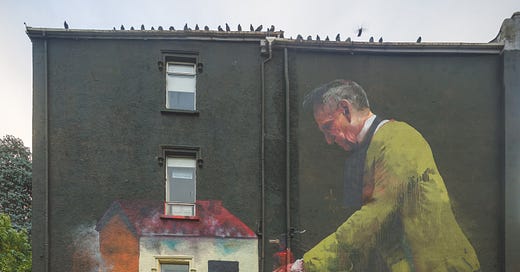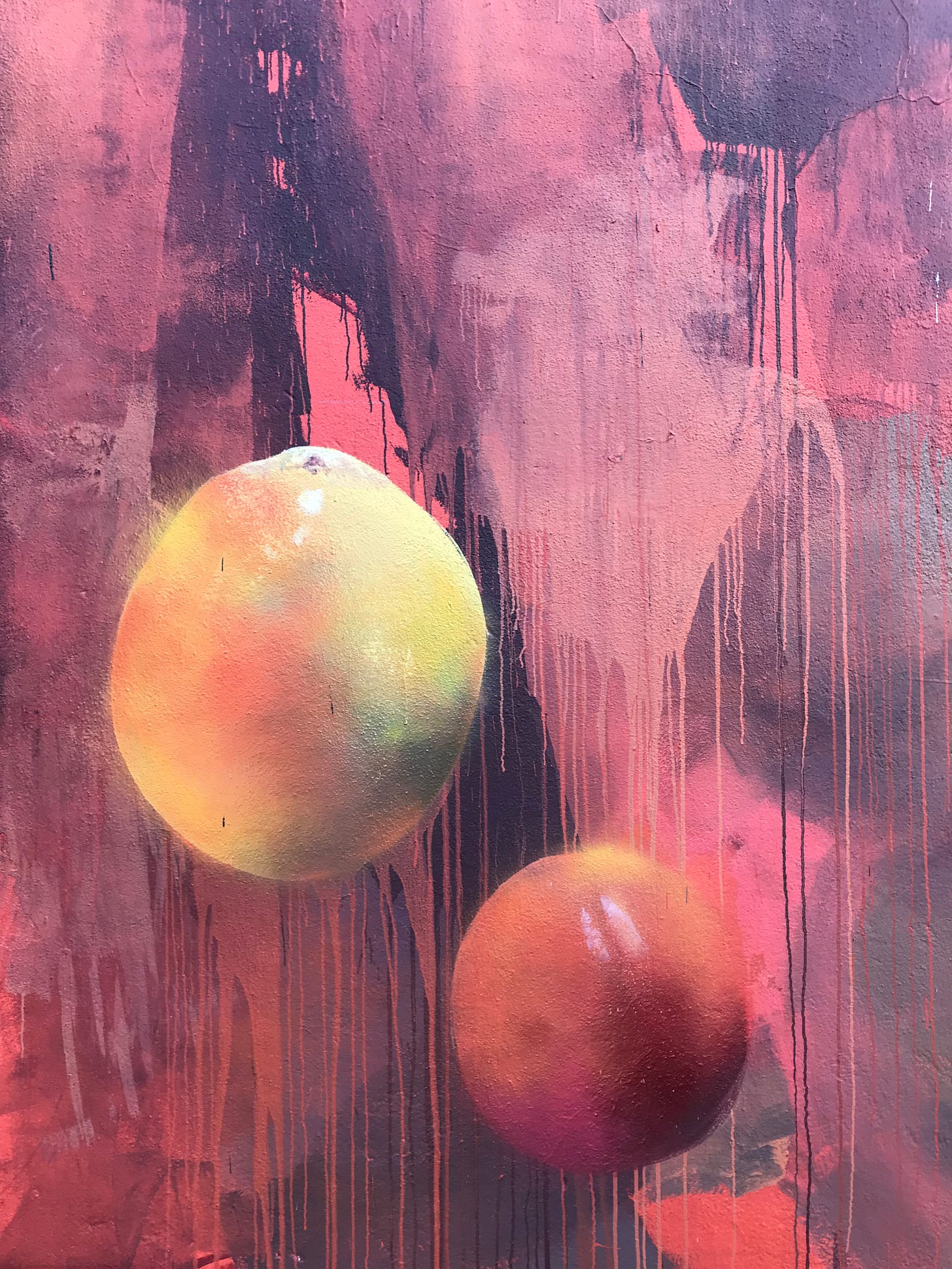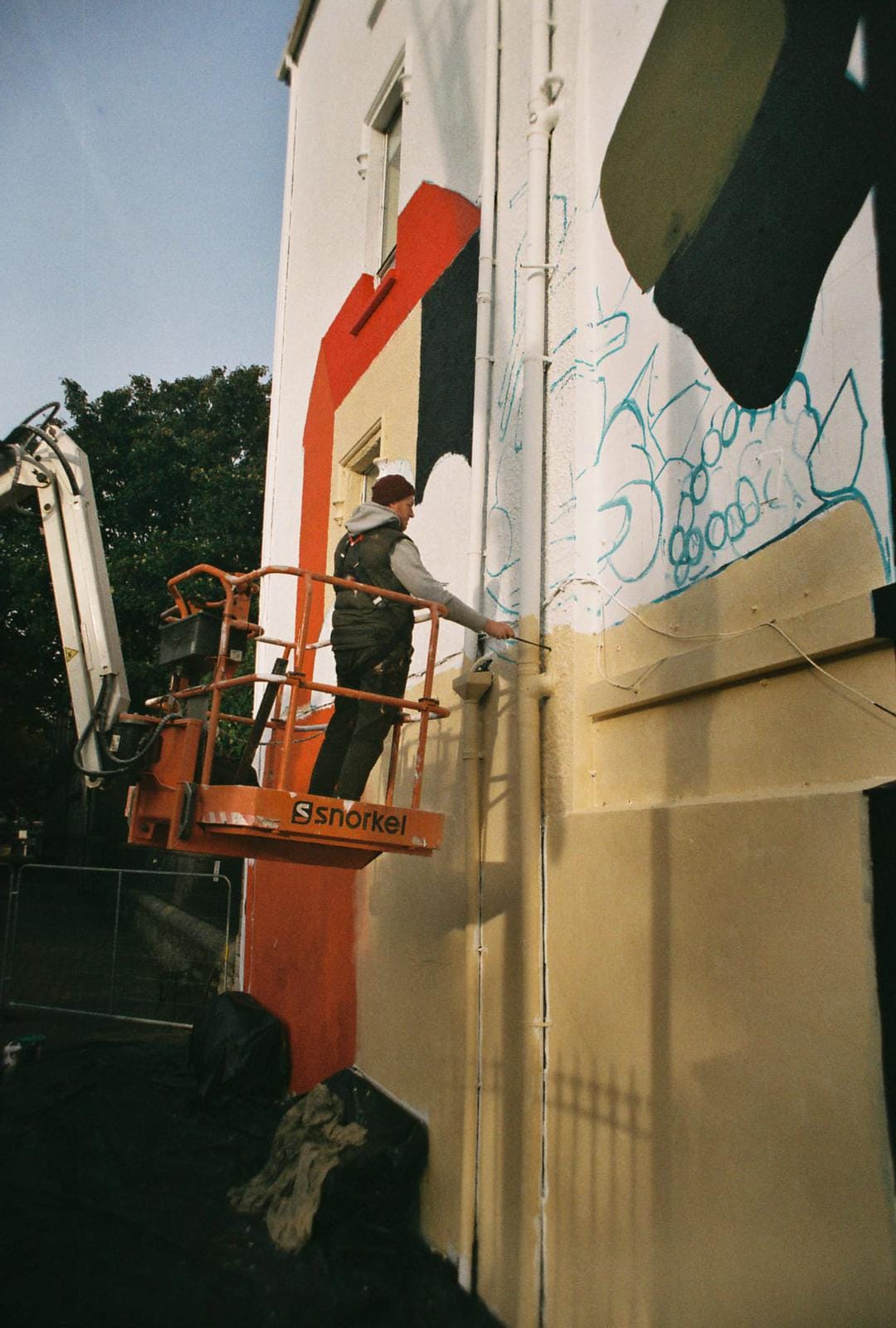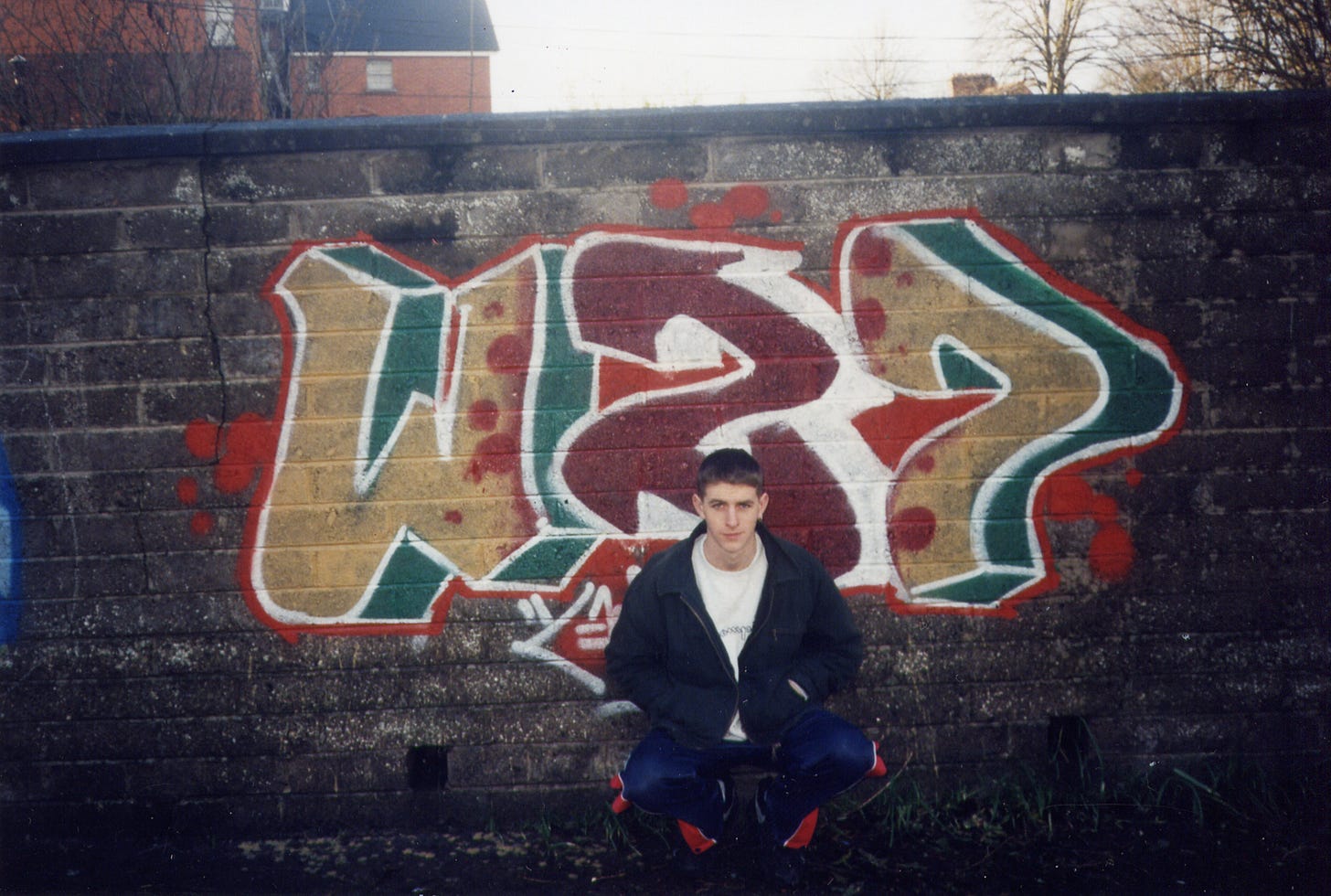Tripe+Drisheen meets Conor Harrington
For 10 days this October, Bishopstown boy Conor Harrington was back in Cork and back up a cherry picker. He left his mark on Grand Parade.
True story: For the title of my final year dissertation I gave it the grandiloquent title “Towards an analysis of public art”. Twenty years on I couldn’t tell you the first thing that’s in there and I pity the poor lecturer who had to suffer through it, but I was mighty proud of that academic and pompous sounding title. Especially the towards part. It encapsulated so much postmodern vagueness.
I was reminded of the title one morning this week while standing in Bishop Lucey Park (also and incorrectly known as the Peace Park) at the railing that encloses the pool of dirty water, dead birds and rubbish while looking up at Conor Harrington’s giant new mural. I absolutely love the giant pieces of fruit falling. Great painters paint great fruit.
While I was waiting for the videographer whom I work with to show up, an elderly lad sauntered over and asked me if I had painted the new mural, before asking me what it was all about. I answered no to the first part, but added that I knew the artist. As to what it’s all about, well I said something along the lines of it’s whatever you want it to be. It’s a bit of a cop-out answer, I know, but I wanted to know what he thought it was about.
He was straight in with his analysis.
He said it was too abstract. He said it was a lovely painting. And then he said that I should tell the artist to cop on.
This was his analysis. Nothing towards about it.
What’s great about Ardú is the way it’s set up: it puts public art, massive pieces of very visible public art (and artists), right in front of people. It’s forcing analysis and conversation and puzzlement as well tweets and posts, photos and videos across the spectrum of social media.
This year, for its second year, there was a smaller crew of artists in town for Ardú, an artist-led and publicly funded project. But the arrangement was the same: give each artist buckets and buckets of paint, a prominent wall in the city and a short enough window of time. The transformation of each wall was a sight to behold.
“Still mind blowing looking at the progress shots compared to the final piece,” David O’Sullivan, a photographer who assisted Conor throughout the transformation, wrote on Instagram this week. And he’s right.
Conor was the last to arrive and the last to leave. But for the duration of his stay in Bishop Lucey Park he was haunted with the weather. I caught up with him on the night he finished up, the day before he flew back to his family in south London. He was fairly bate then after 10 days of painting in public.
Over a few pints in Dennehy’s he must have said “shur lookit” twenty times, and you know what, sometimes that’s all there is to say.
Back in London, as he slipped back into family, studio and napping life Conor answered a few questions about his newest mural, his first large scale piece in Cork, and his first since the pandemic put the kibosh on, well, just about everything.
T+D: Unpack the Grand Parade mural for us, if you will? I see fruit in there, but possibly also metaphors, and does this piece have a name?
Conor Harrington: There’s a lot going on in it but I used the English Market in Cork as a starting point. Ultimately, the mural is an assemblage of ideas, but the The Market is where I began planning the scene. A lot of the city centre was built in the 18th Century, hence the historical stylings. I often use this era in my paintings but my work is rarely about the past as I like to use this dress code as a lens to which we view the present. The abundance of fruit on the table is the main nod to the market but as in a lot of my studio work I am interested in power and excess, that tipping point before a collapse. There’s a lot of talk in Ireland about the housing crisis, younger people are finding it harder and harder to find affordable homes, so my larger than life protagonist looms over the small dwelling on his table. I also included a fire extinguisher on the table as a reference to the Burning of Cork 101 years ago.
There’s been lot of water under the bridge since you last painted a wall in Cork: you’re a Dad, your home is no longer in the EU, and the no 8 bus is now the 208!, but how else has Cork changed since you last painted here?
There’s a hell of a lot of good coffee to drink, top class Japanese food, and the city centre is wonderfully multi-cultural, but the homelessness and addiction issue is a lot more noticeable than before. Despite being home for nearly two weeks I had my nose to the wall for the majority of my stay so that’s as far as my observations have taken me.
Speaking of last painting here, do you remember where exactly it was that you last painted in Cork before moving to London, and what you did?
I’ve done a few smaller graffiti pieces with friends over recent years that went under the radar but my last detailed wall would have been during the jam for the 2005 City of Culture.
Was art your best subject in school?
Yes.
As has been well documented, you’ve painted walls in Sao Paulo, Belfast, Miami, The West Bank, Copenhagen, and Paris to name a few. Common to all is you and a wall and your motif of the colonial-era soldier, sometimes more than one. Is the experience of painting each of these walls quite similar in terms of process?
The process is similar although I tweak it every year. Ten years ago I used only spray paint, then I transitioned to only emulsion and my Cork mural is the first in a while to use both again. My most recent murals have been more carefully tailored to the location and to be honest my Cork mural was a bit of a challenge for me at the planning stages. I felt under more pressure, its home and people have been asking why I haven’t painted there for years. Also, there’s a great anonymity and freedom in painting in huge cities. There are still communities in megalopolises that care greatly for their immediate surroundings but in general the smaller the city the larger the mural looms in the presence of the populous. And I just knew some of the lads from school would be in to shout abuse!
Was it a question of when and not if you would paint a wall in Cork?
Yes, but I needed an organisation like Ardú to do all the hard work for me.
Did you get many heads coming up to you while you were painting in Cork?
Every time I turned from the wall there was a familiar face, which is amazing and frustrating as I didn’t have much time for chats. I’m also isolated to a degree from the general public up on the lift but you’ll always get questions flying up. And they nearly always come from a good place, people are happy and curious when something new happens in their environment so thankfully I didn’t get any criticisms.
I have a technical question: many of the muralists paint shapes, circles, squares, squiggles on to the wall and then paint over them. What’s that about?
That’s a doodle grid, a process whereby an artist paints a number of doodles on a wall and transposes their source image over in on Photoshop so that they can easily map it out on the wall. I use an old fashioned grid with chalk and a spirit level. Reading my image through a series of doodles would hurt my head.
Was it all work and no play while you were back in Cork?
All work. I go into ‘Monk Mode’ when I paint, stay away from the pub and get to bed early. I don’t think people realise how physical a mural is. Also, if it starts to go wrong (which often happens) you’re failing in public. The public might not notice a piece taking a funny turn but it can still be very stressful so I try to keep distractions to a minimum. Its like doing the Leaving Cert (twenty-three years later and I’m still comparing things to the Leaving Cert)
When you paint, and indeed Friz, Asbestos, and Shane O’Malley (the three other painters for Ardú 2021), so much of what you do is micro documented on social media. Do you mind that? Or do you feel like you just have to accept the fact that social media, especially Instagram, is where art is mediated?
Artists were early adopters of social media and it has been infinitely beneficial for us so I can’t complain really, even if people are documenting the awkward middle phase that I wish nobody ever saw.
Can we go back to the no 208 bus? You were in and out the road to Bishopstown where you grew up and where your mam lives while you were here. How does it compare to the old no 8?
Well there’s Wi-Fi and I’m too old to write my name down the back! I was on the 7.34 a.m. (or thereabouts) bus into town every morning and it was a lovely way to mentally prepare for the day ahead.
Your wife Chloe Early - also from Cork - is a painter. There’s not a lot of couples who are painters on my radar. Do you help each other talk through your art and ideas?
Definitely. We’re like a spare set of eyes for each other. And she gets at least one emergency call during every wall where I think I’m losing the battle but she always talks me away from the ledge. We’ve shared a two room studio up until recently so we’ve been a huge part of each other’s practice. We used to take it all home with us too which made it harder to switch off but having two kids has kept our house a work-free zone for the most part.
You and Chloe have two beautiful buachaillí. If, a few years down the road, either of them said they wanted to become a painter, how would you feel, what would you say?
The older guy shows such little interest so I probably wouldn’t believe him! Its not the easiest industry in the world so I’d tell them to keep their eyes open and their head down. I was very naïve when I first moved to London but in a way I think that naivety and optimism helped me. if I had known how hard it actually is to break in to the art world I probably would have run back home again.
Can we talk process again? How many cans of paint did you go through and when you're working at scale like that and do you ever get lost, if that makes sense?
I had around 110 litres of paint (very kindly donated by Pat McDonnell) but I didn’t get through all of it. Its quite a logistical mission staying on top of everything, mixing all my colours and keeping my rollers and brushes from drying but I had my first ground assistant in the form of Toby from Ardú and he kept everything in order while I was up top making paint run.
As you probably know (from reading T+D!!!) Cork is heading into an era of big changes. A few years from now Bishop Lucey park will be transformed. What are you looking forward to seeing change in the city? Conversely, what should stay the same?
Cork is a great city with huge potential and the new investment is very exciting but I really hope it won’t be another steel and glass colony with all the usual bland chain stores you find in other glass boxes round the world. I saw a lot of homelessness while I was back so I hope some of the investment will go towards helping the parts of our society that need it the most. We need to invest in our community and small businesses and help them to thrive and I want to come back and paint R+H Hall!
Your last gallery show was pre-pandemic at Pace in London, and with Heni you brought out a beautiful catalogue of that show and your wall paintings from around the world. Have you plans to start working on a gallery show again?
I’m half way through my new show so hopefully the schools stay open for long enough for me to finish it.
When you’re not painting, what entertains you?
The gym and the telly. I’m just a mainstream dad at heart. No bohemian ways for me.
Slowly, Cork city is making a space for graffiti artists: there’s Ferry Walk down by the Mardyke, Crane Lane in town and of course Ardú. Things have come along since you were tagging in Cork. Was that inevitable and does this evolution somehow take the edge off graffiti?
Yeah the world is changing with regard to graffiti and street art. Unfortunately you could still get stopped by the police for painting flowers without permission and get away with it but if you tag you’re going to get in trouble so graffiti writers are still facing harsher treatment compared to their more floral peers. I prefer tags to flowers.
Any hecklers show up on Grand Parade? Any funny or strange incidents you observed from your vantage point over the 10 days you were painting?
No hecklers but someone got robbed and there was also a mass brawl between teenagers during the day. Fairly standard behaviour for around town at the weekend.
Will you miss the pigeons?
I’m still finding feathers in strange places.

You occasionally bring out books and prints through Hungry Boy Books. Can you tell us a little bit about that?
I set up Hungry Boy Books a few years back to sell my editions, books and zines. Its nice to have full control over when and where I release things. I’ll still collaborate with other imprints but HBB is the primary source for my editions.
Your brother Kevin, a harp maker, finally made the move back to the promised land of Cork this year via Wicklow and London before that. You see where I’m going with this...
Unlikely, but Covid and self-isolating has made me want to spend more time in Cork than I have been doing over the years.
It would be remiss if I didn’t say it, but cop on and keep it up Conor.
As part of a fundraiser to cover costs, Ardú are raffling a signed photo print of artwork painted at the 2020 event by artists Maser, Peter Martin, Shane O’Driscoll, Deirdre Breen, Garreth Joyce, Aches or James Earley, taken by photographer Clare Keogh. For details click on the post below.












Hurray for this piece! And *please* for Conor to come back and paint R&H Hall!